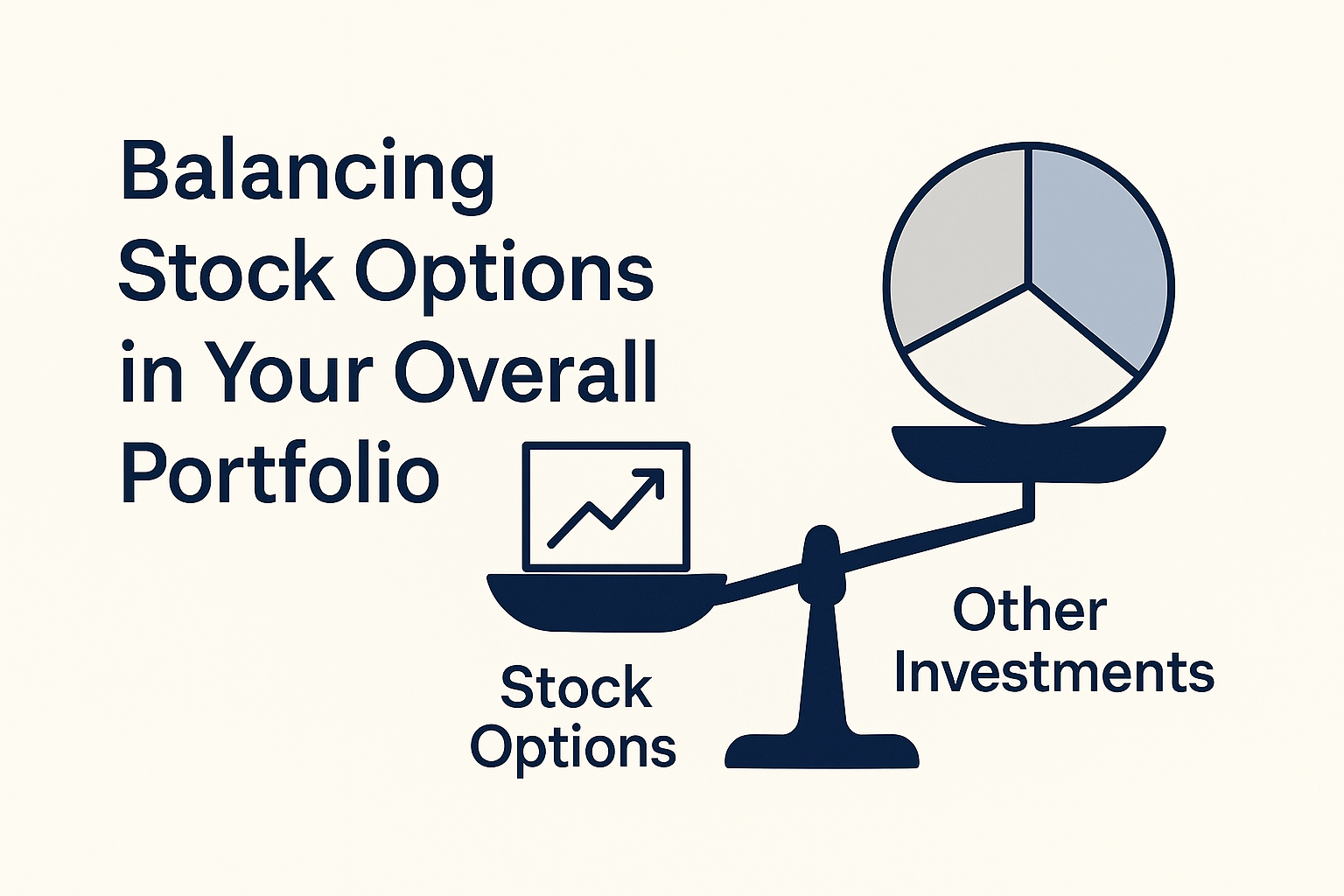Written by Hazel Secco, CFP®, CDFA®
Estimated reading time: 11 minutes
It’s no secret that women are underrepresented in senior leadership roles. Despite this disparity, stock options can be a powerful wealth-building tool for professional women planning for retirement. However, navigating the complexities of stock option grants, vesting schedules, and exercise strategies can be overwhelming—especially when trying to integrate these decisions into your broader retirement planning.
As a professional woman with stock compensation, you face unique challenges: longer life expectancy than male counterparts (requiring more retirement savings), potential career interruptions, and the need to balance company loyalty with portfolio diversification. This guide will help you understand how to optimize your stock options specifically for retirement planning, maximize their value, and avoid common pitfalls that can diminish their impact on your long-term financial security.
Table of contents
- Understanding Stock Options Basics
- Tax Considerations for Stock Options
- Strategic Timing for Stock Option Exercises
- Balancing Stock Options in Your Retirement Portfolio
- Case Study: Optimizing Stock Options for Long-Term Growth
- Conclusion and Next Steps
- Frequently Asked Questions About Stock Options and Retirement
- You Might Also Like
- References
- Disclosures
Understanding Stock Options Basics
Types of Stock Options You Might Hold
Stock options come in two primary varieties, each with distinct characteristics and tax implications:
Non-Qualified Stock Options (NQSOs): The most common type of options, NQSOs give you the right to purchase company stock at a predetermined price (the “strike price”). When exercised, the difference between the market value and your strike price is considered ordinary income and is taxed accordingly.
Incentive Stock Options (ISOs): These offer potential tax advantages compared to NQSOs. With proper planning and holding periods, gains from ISOs may qualify for long-term capital gains treatment rather than ordinary income taxes. However, ISOs can trigger Alternative Minimum Tax (AMT) considerations.

How Vesting Schedules Work
Stock options typically follow a vesting schedule that determines when you can actually exercise your right to purchase shares. Understanding your specific vesting schedule is critical for retirement planning:
- Cliff Vesting: With this approach, you must wait for a specific period (typically one year) before any options vest. After the “cliff” date, that initial portion becomes fully vested.
- Graded Vesting: This more common approach distributes your vesting over time. A typical schedule might be 25% per year over four years, meaning you gain access to one-quarter of your options each year.
- Performance-Based Vesting: Some companies tie vesting to specific performance metrics (either individual or company-wide). These schedules add another layer of complexity to planning.
Whatever your vesting schedule, it’s crucial to understand what happens to unvested options if you retire. Some companies allow for continued or accelerated vesting upon retirement, while others may forfeit any unvested shares—a critical consideration in your retirement timeline planning.
Tax Considerations for Stock Options
Critical Tax Planning for Different Option Types
The tax implications of stock options can significantly impact their value in your retirement planning:
- For NQSOs: When you exercise non-qualified options, you’ll pay ordinary income tax on the spread between your strike price and the current market value. This tax hit applies even if you don’t sell the shares. Planning exercise timing around tax brackets and other income can minimize this impact.
- For ISOs: With incentive stock options, you can potentially defer income recognition until you sell the shares. However, the spread at exercise may trigger AMT liability. If you hold the shares for at least one year after exercise and two years from the grant date, you can qualify for long-term capital gains treatment on the entire appreciation.
Strategic Tax-Minimization Approaches
Consider these approaches to optimize the tax impact of your stock options:
- Exercise and Hold: For ISOs, exercising early and holding shares can convert future appreciation from ordinary income to capital gains—potentially reducing your tax rate by 15-20%. However, this strategy requires careful AMT planning and involves taking on single-stock risk.
- Exercise and Sell: This approach (often used with NQSOs) minimizes single-company exposure but typically results in ordinary income treatment. Strategic timing of these transactions can still provide tax benefits.
Professional women often benefit from a multi-year exercise strategy that spreads tax impact across several years while aligning with broader retirement planning goals.
Strategic Timing for Stock Option Exercises
Key Factors in Exercise Timing Decisions
The question of when to exercise your stock options involves balancing numerous factors:
- Company Outlook: Assess the company’s growth prospects objectively. Many employees overestimate their company’s potential due to familiarity bias. Examine analyst ratings, industry trends, and competitive positioning with the same rigor you’d apply to any investment.
- Stock Volatility: Companies with highly volatile stock prices may warrant earlier exercise decisions to lock in gains, particularly as you approach retirement, when recovery time from significant downturns becomes limited.
- Personal Financial Timeline: As retirement approaches, your risk tolerance naturally decreases. Consider shifting from a growth mindset with your options to a more preservation-focused approach 5-7 years before your planned retirement date.
- Vesting Acceleration Provisions: Some companies offer accelerated vesting upon retirement if certain age and service requirements are met. Understanding these provisions may influence your retirement timing decisions.
Timing Considerations for Professional Women
Women face unique timing considerations with stock compensation planning as well as retirement planning.
- Career Breaks: If you anticipate potential career pauses (for caregiving or other reasons), prioritize exercising options that would otherwise expire during these periods.
- Longevity Planning: Women’s longer average lifespans mean more retirement years to fund. Consider this when deciding between immediate liquidity and potential long-term appreciation of your options.
- Transitioning to Consulting: Many professional women transition to consulting roles before full retirement. Some companies allow option exercise during these transitional phases, while others may treat them as separation events that trigger expiration clocks.
The optimal exercise strategy often involves a staged approach rather than an all-or-nothing decision, allowing for diversification while maintaining some upside potential.
Balancing Stock Options in Your Retirement Portfolio
Avoiding the Concentration Risk Trap
One of the most significant risks professional women face with stock options is overconcentration. We, as financial advisors, typically recommend limiting single-stock exposure to 5-10% of your portfolio. However, successful stock option grants can easily exceed this threshold.

Consider these diversification strategies:
Systematic Diversification Plan: Create a schedule to gradually diversify your company stock position over time, particularly as retirement approaches. This disciplined approach helps overcome emotional attachment to company shares.
Core-Satellite Approach: Maintain a “core” retirement portfolio of diversified investments while allowing a smaller “satellite” portion for concentrated positions like company stock.
Hedging Strategies: In some cases, using options or other hedging techniques can help manage downside risk while maintaining your position. These strategies require sophistication but can be valuable for significant positions.
Integration with Other Retirement Assets
Your stock options should be viewed as one component of your overall retirement strategy:
- Portfolio Role Clarity: Define whether your stock options will serve as your growth engine, supplemental income source, or legacy planning vehicle. This clarity helps determine appropriate exercise and diversification timing.
- Sequence of Withdrawals Planning: Determine where stock option proceeds fit in your retirement withdrawal strategy. Professional women with stock options can utilize their options proceeds as a bridge between early retirement and when other income sources (Social Security, pensions) begin.
- Roth Conversion Funding: For some women, using stock option proceeds to pay taxes on Roth IRA conversions can be an effective strategy, creating tax-free income for later retirement years when healthcare costs typically increase.
Remember that emotional factors could often influence stock option decisions more than financial factors. Maintaining objectivity about your company’s prospects is essential for making sound retirement planning decisions.
Case Study: Optimizing Stock Options for Long-Term Growth
Sarah’s Stock Option Strategy
Sarah, a 53-year-old pharmaceutical executive, held significant stock options scheduled to vest over the next five years, with her planned retirement at age 60. Her options had a current paper value of approximately $480,000, representing nearly 30% of her retirement assets.
The Challenge: Sarah needed to determine how to optimize these options for retirement while reducing concentration risk and managing tax implications. She was particularly concerned about healthcare coverage before Medicare eligibility.
The Strategy: After having discussed her priorities and future goals with us, Sarah implemented a three-part approach:
- Staged Exercise Plan: Rather than exercising all options at once, Sarah created a four-year exercise schedule, strategically timing exercises to stay within her current tax bracket.
- Diversification Framework: She immediately diversified 60% of each exercise into a broadly diversified portfolio, while maintaining 40% in company stock to participate in potential continued growth.
- Bridge Account Creation: Sarah designated the proceeds specifically as her “healthcare bridge fund,” dedicated to covering health insurance costs between retirement and Medicare eligibility.
The Outcome: By implementing this strategic approach, Sarah reduced her single-stock exposure from 30% to 12% of her portfolio while creating a dedicated fund for her most significant early retirement expense. Her staged exercise strategy not only provided greater tax efficiency but also resulted in $46,000 in tax savings compared to a lump-sum exercise.
The key lesson from Sarah’s experience is that successful stock option planning for retirement requires integration with your overall financial plan rather than viewing options in isolation.
**The above are hypothetical situations based on real-life examples. Names and circumstances have been changed.
Conclusion and Next Steps
Stock options can significantly enhance your retirement security when managed strategically. As a professional woman, optimizing these valuable assets requires balancing tax considerations, timing decisions, and portfolio integration while accounting for your unique life circumstances.
The most successful approach typically involves:
- Gaining clarity on exactly what type of options you hold and their vesting provisions
- Creating a multi-year exercise strategy aligned with your retirement timeline
- Implementing a systematic diversification plan to reduce concentration risk
- Integrating option proceeds strategically with other retirement assets
- Regularly revisiting your strategy as company performance and personal circumstances evolve
Before making any stock option decisions, consider how they fit into your comprehensive retirement strategy. The right approach depends on your specific situation, goals, and risk tolerance.
Are you ready to get started with customized solutions for your stock options? Book a complimentary call with us to learn more about how stock compensation planning can enhance your financial future.
Frequently Asked Questions About Stock Options and Retirement
When should I exercise my stock options for retirement planning?
The optimal timing depends on several factors including your retirement timeline, tax situation, and the company’s prospects. Generally, as you approach within 5-7 years of retirement, consider beginning a systematic exercise strategy to reduce single-company risk. This approach allows you to gradually diversify while potentially capitalizing on continued company growth.
How does a stock option vesting schedule affect my retirement planning?
Your vesting schedule directly impacts when you can access your equity compensation, potentially constraining your retirement timing. Review your grant documents to understand what happens to unvested options if you retire. Some companies allow continued vesting for retirees meeting certain age and service requirements, while others terminate unvested options upon separation, regardless of reason.
What happens to unvested stock options if I retire?
This depends entirely on your company’s specific plan documents. Some companies offer retirement-favorable provisions that allow continued vesting if you meet defined criteria (typically a combination of age and years of service). Others may accelerate vesting upon retirement or, conversely, forfeit all unvested options. This policy should significantly influence your retirement timing decisions.
Should I diversify my stock options before retirement?
In most cases, yes. Financial advisors typically recommend limiting single-stock exposure to 5-10% of your portfolio, particularly as you approach retirement when recovery time from significant downturns becomes limited. Consider implementing a systematic diversification plan that gradually reduces concentration risk while potentially allowing some continued participation in company growth.
How are stock options taxed when used for retirement income?
For NSOs, you’ll pay ordinary income tax on the spread between your strike price and market value when exercised, regardless of whether you hold or sell the shares. For ISOs, with proper planning and holding periods, you may qualify for long-term capital gains treatment, potentially reducing your tax rate by 15-20%. Once exercised and held, subsequent appreciation or depreciation is taxed as capital gains or losses when you sell shares during retirement.
Can I roll stock options into an IRA or 401(k)?
No, stock options themselves cannot be rolled directly into retirement accounts. However, after exercising options and selling the resulting shares, you can potentially contribute some proceeds to retirement accounts (subject to annual contribution limits). For some executives, nonqualified deferred compensation plans may offer additional tax-advantaged savings opportunities beyond traditional retirement accounts.
How do I evaluate whether to hold or sell company stock after exercising options?
After exercising options, evaluate your company stock the same way you would any investment: based on future prospects rather than past performance. Consider: (1) what percentage of your overall portfolio it represents, (2) the company’s competitive position and growth outlook, (3) your personal risk tolerance, and (4) your need for diversification.
You Might Also Like
References
[1] – https://www.highlandplanning.com/learning-center-1/mastering-equity-compensation-a-guide-for-pharmaceutical-executives
[2] – https://www.sciencedirect.com/science/article/abs/pii/S0304405X12001183
[3] – https://www.linkedin.com/pulse/stock-options-new-biotech-firms-dealing-early-hires-buyout-
[4] – https://www.executivewealthplanning.com/blog/retirement-planning-with-stock-compensation
Disclosures
The opinions voiced in this material are for general information only and are not intended to provide specific advice or recommendations for any individual. We suggest that you discuss your specific tax issues with a qualified tax advisor.
There is no guarantee that a diversified portfolio will enhance overall returns or outperform a non-diversified portfolio. Diversification does not protect against market risk.
No investment strategy assures a profit or protects against loss.
Investing involves risks, including possible loss of principal.
Rebalancing a portfolio may cause investors to incur tax liabilities and/or transaction costs and does not assure a profit or protect against a loss.

